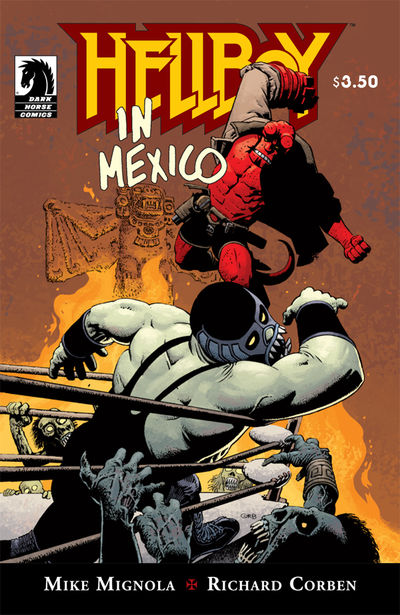
You might have seen the ads in our books, the push on Twitter and Facebook, and the stories on the Net. Dark Horse wants you to show your love for the greatest paranormal investigators of all time, and join the B.P.R.D.
Find out what that’s all about at www.darkhorse.com/jointhebprd, but as Mike Mignola’s long-suffering editor, I’m here to tell you why we’re making this push for the books. If you’ve been reading them, you know that things are reaching critical mass. We’re entering the final arc of Mike and Duncan Fegredo’s saga in Hellboy: The Storm, in which Hellboy has to make hard choices or face the destiny he’s been warned of for so long—becoming the Beast of the Apocalypse. And this month with Mike, Guy Davis, and John Arcudi in B.P.R.D., we wrap up the frog war, which began in the very first issue of Hellboy, in 1994, and kicked into high gear when the Bureau for Paranormal Research and Defense got its own book in 2002. Now the frog war ends, and in the next couple of months we’ll begin the aftermath: the consequences of Liz Sherman’s desperate effort that won the war.
I was a fan when the first issues of Hellboy came out. The original editor, Barbara Kesel, handed it over to me when she left Dark Horse around the release of the Seed of Destruction trade paperback. I loved the book right off the bat, and it’s been an honor watching it grow over the years. Mike and I have taken great care to make sure it grew in the right ways. We held back at times, making sure the line stayed true to the ideas that Mike had going into it, even though that original vision has evolved so much.
And while the line has grown, it remains a focused story about the approaching end of the world, full of some characters who want to prevent it, some who want to hasten it, and, perhaps most uniquely, some who simply want to observe and tilt the scales a little bit in one direction or the other. The wisest characters in Mignola’s books seem to be those who just want to be in the right place when the inevitable end comes.
Our heroes are constantly pitted against supernatural menaces who either believe they’re aiding in the natural evolution of earth, or delivering it into the hands of mad gods from whom they expect some reward or mercy. Rasputin and Memnan Saa, and even the Miracle Boy of West Virginia, have tried to take charge of the end of mankind. Other characters, like the Bog Roosh and Hecate, have tried to push Hellboy into his role as Beast of the Apocalypse. Astaroth continues to make the case for Hellboy to accept his crown; but for Astaroth, it has less to do with mankind than with what the end will mean for the hierarchy of Hell—about which you’ll learn more in the next major phase of Hellboy’s career.
At a convention recently, I was at dinner with artist/writers Jim Rugg (Afrodisiac, The Guild) and Tim Seeley (Hack/Slash, WildCATS), talking about the unique storytelling advantages of comics and why to tell a story in comics over some other medium. Tim’s take was simple and from the gut. He said, “I find it so frustrating when people treat comics as the inferior little brother of film. I don’t know what it is, but no movie has ever given me the same joy that I get out of a comic.” I couldn’t agree more. And no one alive today is better than Mignola at creating four-color worlds every bit as fun and engaging as the best of Kirby’s work, with a modern level of sophistication, and a classic sense of wonder.
So celebrate Cinco de Mayo with Hellboy in Mexico; celebrate the end of the frog war in King of Fear with a team that doesn’t look much like the team from Hollow Earth (or Seed of Destruction, for that matter!), and join the B.P.R.D. for a lot more weirdness in the months and years to come.
-- Scott Allie